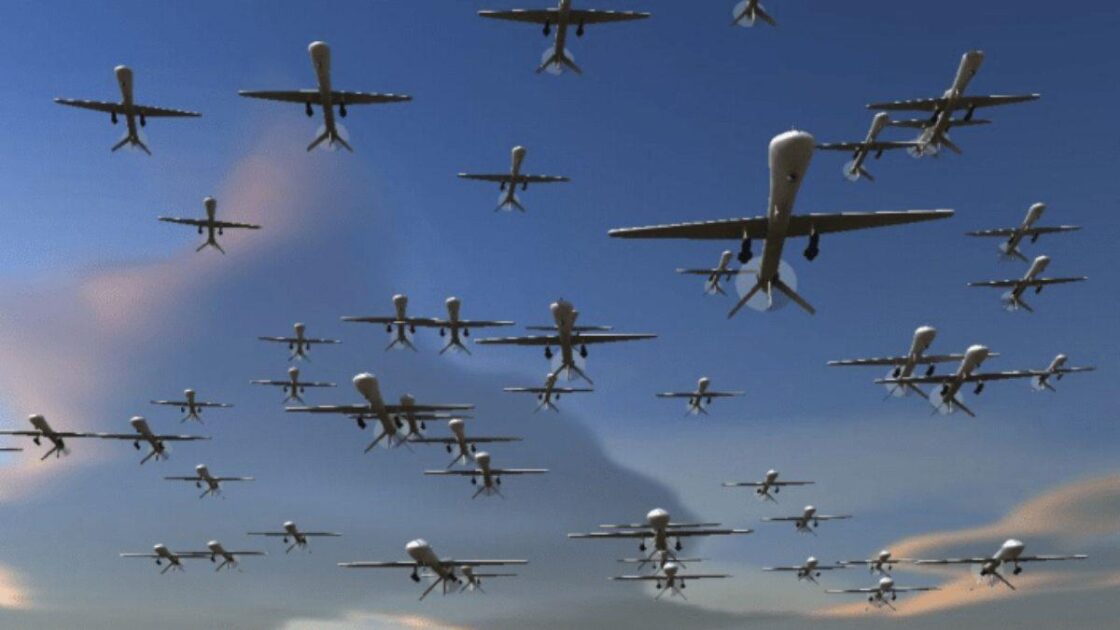Imagine a world where hundreds of drones work together seamlessly, performing complex tasks with efficiency and precision. This is not just science fiction – it’s the future of unmanned flight. Drone swarm technology is revolutionizing the way we think about aerial operations, offering a glimpse into what the future holds for autonomous systems. Join us as we dive into the world of drone swarms and explore the endless possibilities they bring to the table. Are you ready to witness the next big thing in aviation?
1. Understanding the Concept of Drone Swarm Technology
Picture a sky filled with dozens, even hundreds, of drones moving in sync, almost like a graceful dance. This is the phenomenon known as drone swarm technology, where multiple unmanned aerial vehicles (UAVs) work together in a coordinated manner. The concept of drone swarms opens up a world of possibilities in terms of efficiency, flexibility, and scalability in various industries.
As drones continue to evolve and become more advanced, the idea of leveraging swarm intelligence in UAVs is gaining traction. Swarm intelligence refers to the collective behavior of decentralized, self-organized systems, which in this case, are drones. By mimicking the behavior of natural swarms, such as bees or birds, drone swarm technology can achieve complex tasks that would be impossible for a single drone to accomplish.
The potential applications of drone swarms are vast, ranging from surveillance and reconnaissance missions to package delivery and agriculture. By working together, drones can cover larger areas in less time, communicate with each other to avoid collisions, and adapt to changing environments more effectively. The future of unmanned flight indeed seems bright with the promising capabilities of drone swarm technology.
2. Exploring the Mechanics of Swarm Intelligence in Drones
The mechanics of swarm intelligence in drones are truly fascinating. By mimicking the natural behavior of swarms of animals like bees or birds, drones can work together in a coordinated manner to achieve complex tasks. Through sophisticated algorithms and communication protocols, these drones can communicate with each other in real-time, adjusting their positions and actions to efficiently complete missions. This enables a level of collaboration and adaptability that is unmatched by traditional individual drone operations.
One key aspect of swarm intelligence in drones is decentralization. Unlike a single large drone controlled by a central operator, a swarm of drones can operate autonomously, making decisions collectively based on local information. This allows for greater scalability, robustness, and flexibility in carrying out tasks across various industries. The potential applications of swarm drones in fields such as agriculture, search and rescue, and construction are limitless, offering a glimpse into the exciting possibilities of the future of unmanned flight.
3. Practical Applications and Uses of Swarm Drones in Modern Industry
In today’s modern industry, swarm drones are changing the game when it comes to efficiency, precision, and versatility. These innovative technologies are being utilized in various practical applications across different sectors. From agriculture to construction, swarm drones are revolutionizing the way tasks are completed.
Here are some practical uses of swarm drones in modern industry:
-
Surveying and Mapping: Swarm drones can cover large areas quickly and accurately, making them ideal for surveying and mapping tasks in industries like mining and urban planning.
-
Monitoring and Inspections: With the ability to fly in formation and communicate with each other, swarm drones can be used for monitoring infrastructure, inspecting pipelines, and assessing building conditions.
-
Delivery and Transport: Companies are exploring the use of swarm drones for efficient delivery of goods, especially in challenging terrains or during emergencies.
The potential applications of swarm drones are vast and continue to expand as technology advances. Stay tuned as we delve deeper into the exciting world of drone swarm technology.
4. How Drone Swarms Are Revolutionizing Disaster Response and Recovery
Drones have quickly become a game-changer in disaster response and recovery efforts, but the use of drone swarms takes this innovation to a whole new level. These coordinated groups of drones can cover vast areas in a fraction of the time it would take traditional methods. With their ability to fly in formation, communicate with each other, and adapt to their surroundings, drone swarms are revolutionizing how we handle natural disasters, accidents, and other emergencies.
Benefits of Using Drone Swarms in Disaster Response:
- Rapid deployment and coverage of large areas
- Improved data collection and real-time analysis
- Enhanced search and rescue capabilities
- Reduced risk to human responders
As we continue to push the boundaries of drone swarm technology, the possibilities for their use in disaster management are endless. From delivering emergency supplies to mapping disaster-stricken areas, drone swarms are proving to be a vital tool in saving lives and speeding up the recovery process.
5. Evaluating the Pros and Cons of Deploying Drone Swarms
When considering the deployment of drone swarms, it’s crucial to weigh the pros and cons to make informed decisions.
Pros:
- Efficiency: Drone swarms can cover large areas quickly, making them ideal for search and rescue missions or agricultural monitoring.
- Scalability: As drone technology advances, the ability to scale up the number of drones in a swarm becomes easier, increasing their capabilities.
- Safety: Drones can access hard-to-reach or hazardous areas, reducing the risk to human workers in dangerous situations.
Cons:
- Cost: Setting up and maintaining a drone swarm can be expensive, especially when considering the need for skilled operators and regular maintenance.
- Security Concerns: With multiple drones flying in close proximity, there is a higher risk of signal interference or hacking, potentially compromising data or causing accidents.
- Regulatory Challenges: Navigating the legal and ethical implications of deploying drone swarms can be complex, requiring adherence to strict regulations and privacy laws.
By carefully evaluating these factors, businesses and organizations can determine whether the benefits of drone swarm technology outweigh the challenges.
6. The Future of Drone Swarm Technology: Predictions and Possibilities
The future of drone swarm technology holds endless possibilities and predictions that can revolutionize the world of unmanned flight. With advancements in artificial intelligence and communication systems, the potential for drone swarms to work together seamlessly is on the horizon. Imagine a swarm of drones autonomously coordinating to deliver packages, monitor agricultural fields, or even assist in search and rescue missions in a fraction of the time it would take humans.
As technology continues to evolve, the scalability and efficiency of drone swarms are expected to increase exponentially. One can anticipate seeing larger swarms tackling more complex tasks with greater accuracy and speed. From surveying disaster areas to providing real-time surveillance, the applications for drone swarms are limitless. The future also holds the promise of enhancing swarm capabilities with advanced sensors, better navigational algorithms, and increased autonomy, making them even more reliable and efficient.
In a rapidly changing world, investing in drone swarm technology could prove to be a wise decision for businesses looking to stay ahead of the curve. With the potential to streamline operations, reduce costs, and increase productivity, drone swarms are poised to be the future of unmanned flight.
7. Essential Aspects to Consider for Investing in Drone Swarm Technology
When considering investments in drone swarm technology, it is crucial to evaluate key aspects that can impact the success of your venture. Cost Efficiency plays a significant role, as the initial investment in drone swarms can be high but can provide substantial cost savings in the long run. Scalability is also vital, ensuring that the technology can adapt and grow with the needs of your business.
Regulatory Compliance is another critical factor to consider. As drone regulations continue to evolve, it is essential to ensure that your investment meets all legal requirements. Training and Education for your team are crucial, as operating drone swarms effectively requires specialized skills. Investing in ongoing training can maximize the potential of this technology for your business.
By carefully considering these essential aspects, you can make informed decisions when investing in drone swarm technology, unlocking its full potential and staying ahead in the ever-evolving landscape of unmanned flight.
The Conclusion
drone swarm technology is revolutionizing the field of unmanned flight, offering limitless possibilities for various industries and applications. As we continue to explore and develop this cutting-edge technology, it will be fascinating to see how drone swarms will shape the future of aviation. With its potential for coordinated movements, efficient data collection, and improved safety measures, drone swarms are undoubtedly paving the way for a new era of aerial innovation. Keep an eye on this space, as the future of unmanned flight is certainly looking bright with drone swarm technology leading the way.
References/Sources:
- “Drone Swarms: A New Way for Drones to Fly”
- “The Rise of Drone Swarms in Military Applications”
- “How Drone Swarms are Transforming Search and Rescue Missions”
- “The Potential of Drone Swarms in Agriculture”
- “Challenges and Opportunities in the Development of Drone Swarm Technology”

